Greater Birmingham & Central Alabama’s River & Waterway Restoration Experts
Professional Dredging Services in Center Point, Alabama
-
Cahaba & Coosa River Tributaries
-
Red Clay Sediment Control
-
HOA & Stormwater Expertise
-
Serving Jefferson, Shelby & St. Clair Counties
We know Alabama—The River State. The rivers like the Cahaba, Coosa, and Black Warrior shape Central Alabama’s drainage systems, bringing with them red clay sediment runoff that fills stormwater ponds and neighborhood lakes. Whether you need stormwater pond restoration or neighborhood lake maintenance, we understand what Central Alabama property owners face. We understand how Alabama’s rivers connect every community — from Cahaba’s gentle bends to the Coosa’s reservoirs.
Why Center Point Waterway Owners Choose Us
Here in Central Alabama, our rivers define the land. The Cahaba, Coosa, and Black Warrior systems carry the red clay that gives Alabama its color — and our team knows how to manage the sediment, erosion, and runoff these waterways leave behind. From suburban retention ponds to the Cahaba’s floodplain, we bring local knowledge to every job.
Deep Central AL Waterway Knowledge
- Intimate knowledge of the Cahaba, Coosa, and Black Warrior watersheds
- Understanding of seasonal river flow and drainage systems
- Familiar with tributary-fed lake and pond maintenance
Red Clay Sediment Experts
- Specialized equipment for Central Alabama's red clay in drainage basins
- Effective removal of construction runoff sediment in Jefferson and Shelby counties
- Our work keeps that red clay from choking rivers and local waterways after heavy rains
River & Reservoir Experience
- Knowledgeable about all Corps of Engineers permit requirements for waterways
- Familiar with Alabama Power reservoir schedules (Lay, Logan Martin, Martin)
- Navigate complex Corps and ADEM regulatory guidelines for river systems
HOA & Stormwater Community Specialists
- Expertise in retention ponds, drainage, and culvert maintenance
- Community boat ramp maintenance on tributary-fed ponds
- Solutions for neighborhood lakes fed by local creeks and tributaries
Family & Heritage Waterfronts
- Respect for family homes along the rivers and feeder creeks of the Birmingham metro
- Preservation of heritage waterfronts and private ponds
- Protecting memories for future generations on Coosa/Cahaba tributaries
Straight Talk, Fair Pricing
- Honest assessment of dredging and drainage needs
- Transparent pricing with no surprises
- Focus on local jobs and environmental accountability in Central Alabama
Specialized Dredging Services for Greater Birmingham & Central Alabama, Alabama

Mechanical Excavation Dredging
Ideal for coves on Lake Martin, Lay Lake, and neighborhood ponds across Alabama suburbs. We use sectional barges for precision sediment removal in smaller HOA lakes, handling heavy red clay and dense debris found throughout central and north Alabama.
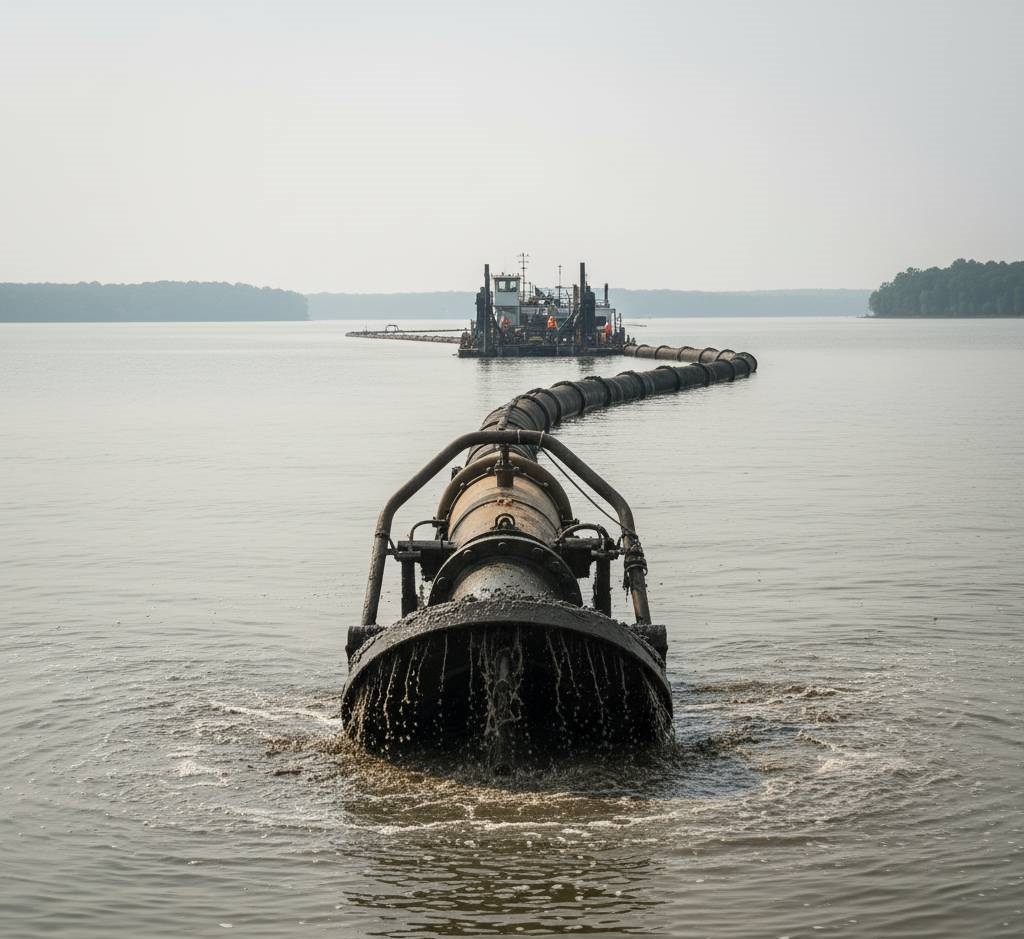
Hydraulic Pumping Systems
Best for large-scale operations on major water bodies such as Guntersville Lake, Wheeler Reservoir, and the Tennessee River system. Our equipment can pump fine silt and muck over long distances to remote dewatering sites, ideal for TVA reservoirs.
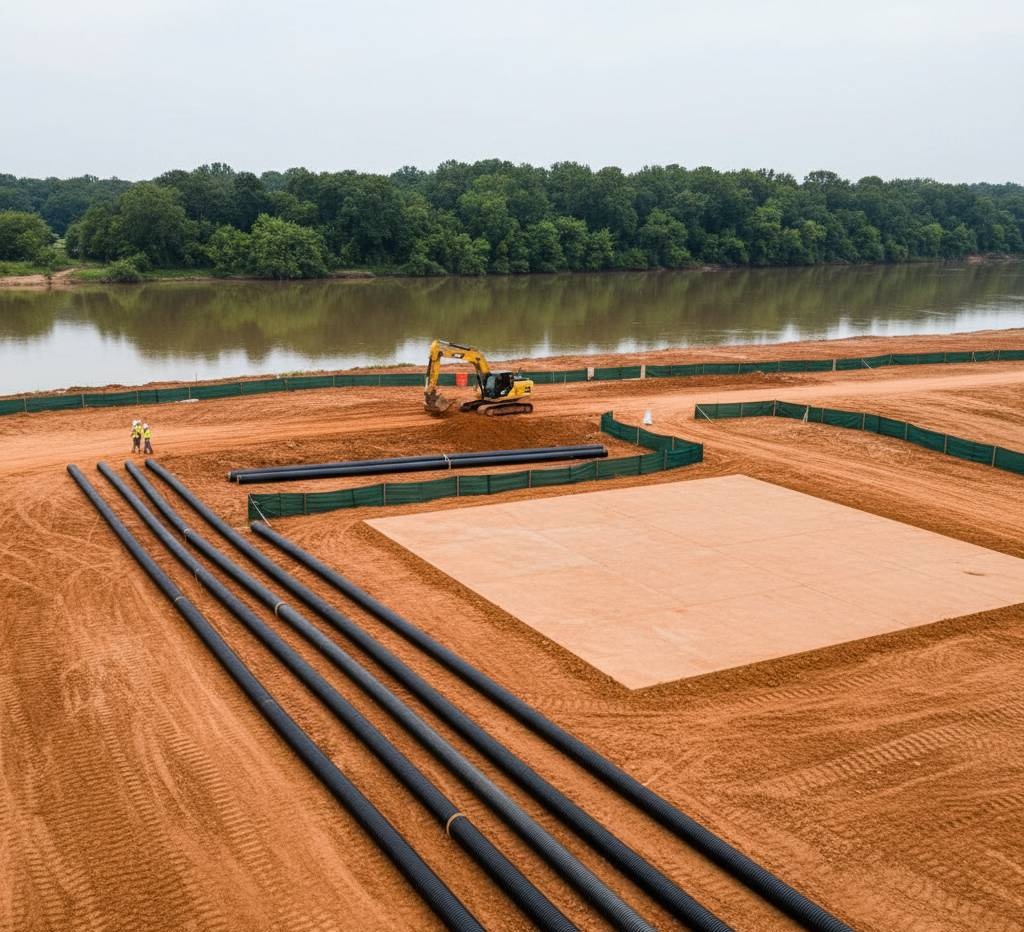
Integrated Sediment Management
A comprehensive approach ensuring compliance with ADEM regulations. This includes on-site dewatering using methods suitable for Alabama's diverse soils (from Tennessee Valley clay to Gulf Coast sand) with approved disposal or beneficial reuse planning.
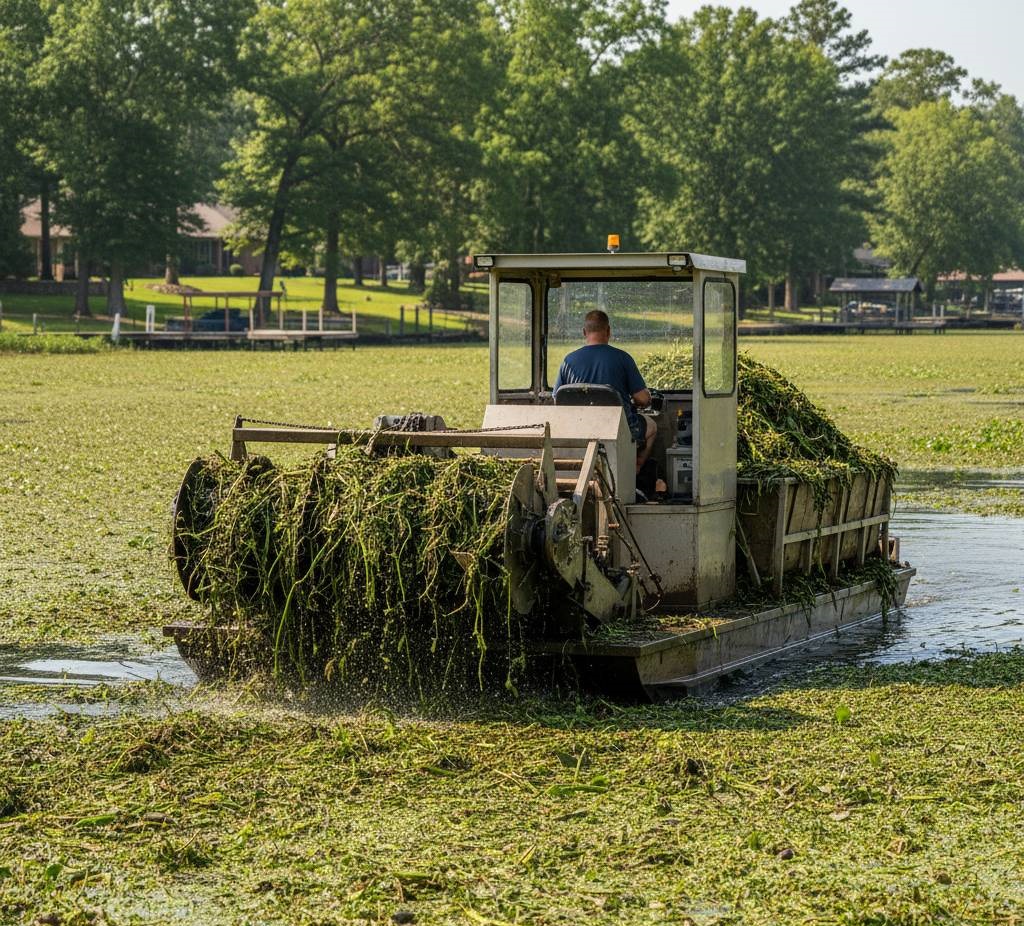
Aquatic Growth Control
Targeted removal of aggressive Alabama aquatic weeds—like hydrilla, water hyacinth, and milfoil—to combat the effects of shallow water and nutrient-rich sediment that cause severe weed infestations in our warm southern climate.
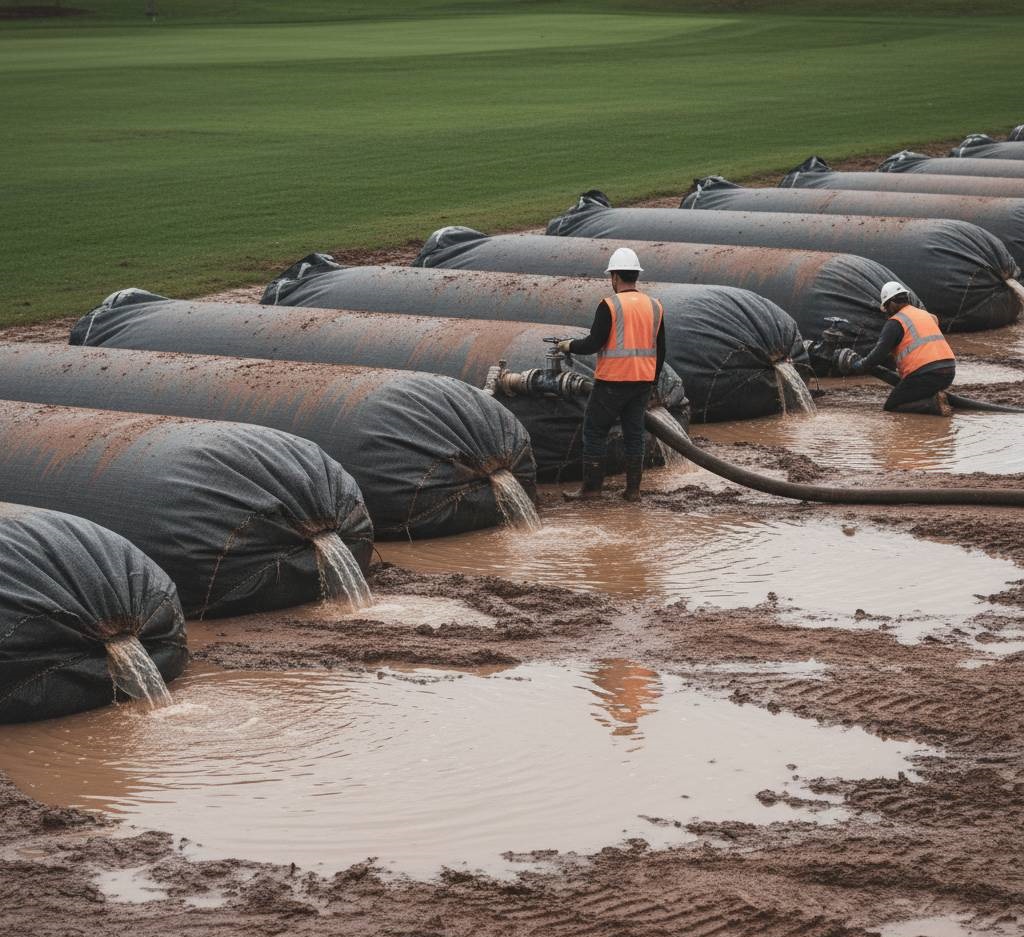
Advanced Dewatering Techniques
Installation and management of Geotextile tubes for efficient dewatering on HOAs, golf courses, and properties across Alabama. We also design and manage upland pad drying operations where available land permits, with special consideration for red clay disposal.
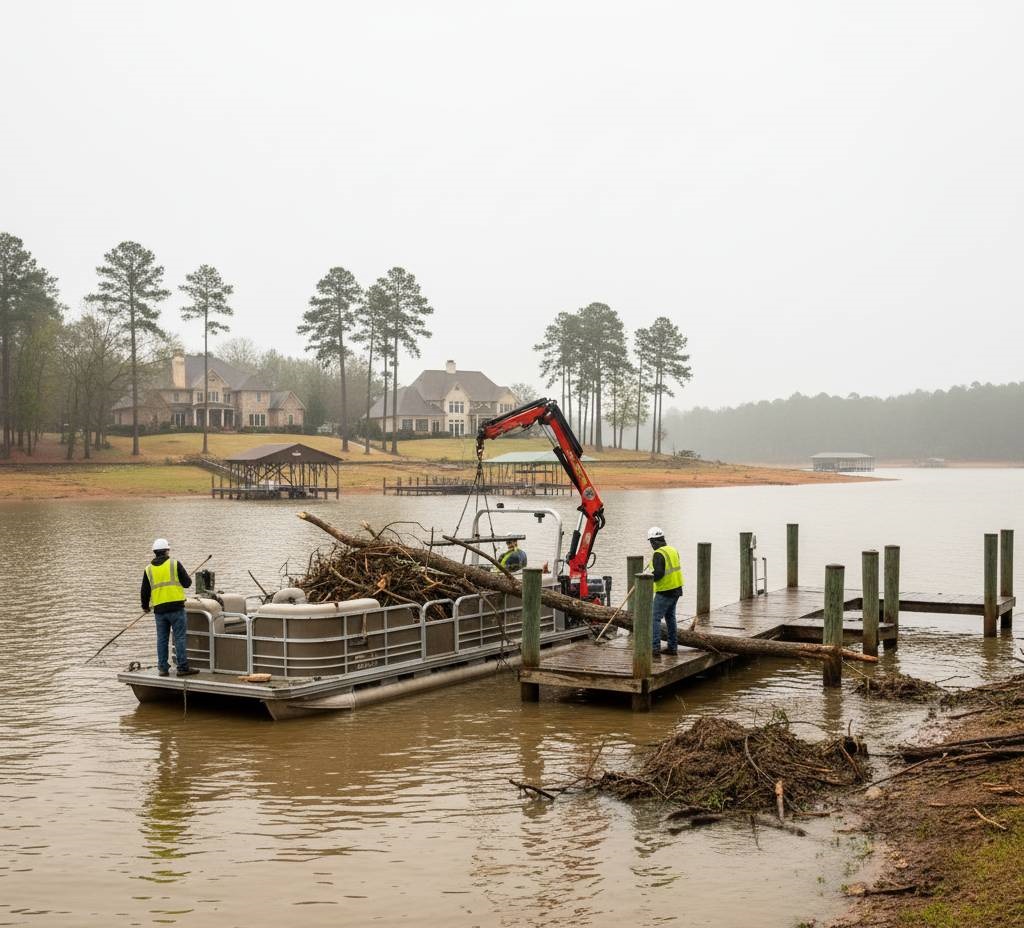
Waterway Maintenance Programs
Post-event cleanup and maintenance after major storms or TVA drawdowns. We offer season-based lake management programs to prevent sediment re-accumulation, particularly important during Alabama's hurricane season and seasonal water level adjustments.
Let's Talk About Your Center Point Lake
Whether you're dealing with red clay sediment buildup, losing dock access, or just noticing your lake isn't as deep as it used to be, we can help. We'll come out, take a look, and give you straight answers about what needs doing and what it'll cost. No pressure, no sales pitch—just honest advice from folks who know Alabama lakes.
Common Questions from Center Point Waterway Owners
Real answers about dredging Central Alabama's rivers, retention ponds, and lakes—based on projects across the Cahaba and Coosa watersheds
Do I need permits to dredge my Center Point lake?
Almost always, yes. ADEM (Alabama Department of Environmental Management) oversees most lake and river work in Alabama. If you're on a major reservoir like those fed by the Coosa River system, you may need approval from the Corps of Engineers or Alabama Power. Dredging a creek, tributary, or retention pond also requires due diligence to ensure you're in compliance with stormwater and environmental regulations.
Good news is, we handle all that paperwork. We know who to call at ADEM and the Corps, what they're looking for, and how to get approvals without months of back-and-forth. You shouldn't have to become an expert in state environmental law just to fix your waterway. That's worth something when you're trying to get your water system ready for the next rainy season.
What's the deal with Alabama's red clay sediment?
Red clay is the hallmark of Central Alabama's beautiful, rolling landscape. When it rains hard, that clay washes into our drainage systems—it travels through the Cahaba and Coosa watersheds, into feeder creeks, and finally settles in local retention ponds and residential coves. New development makes it worse. Over the years, this clay buildup makes water shallower and impairs drainage flow.
The clay itself isn't harmful, but too much of it ruins water clarity and fills in swimming areas. We remove it carefully—the goal is getting your waterway back to proper depth and flow, not stirring up more problems. And once it's out and dewatered, that red clay actually makes excellent, stable fill material.
Where does the dredged sediment go?
We dispose of dredged material at approved Alabama sites, or it can be beneficially reused right on your property—for riverbank restoration, erosion repair, or building up low-lying areas. Red clay sediment, once dewatered and settled, is excellent, stable fill material for many applications in the central part of the state, especially for stabilizing flood-prone areas.
The disposal method depends on sediment quality, your property layout (especially access along a creek or river), and local regulations. We'll explain all your options during the site visit and include disposal costs in our estimate so there are no surprises. Some property owners like keeping the material on-site; others prefer us to haul it away completely.
What type of dredging is best for my Center Point property?
The best method for your property depends on several Alabama-specific factors: sediment type (soft muck vs. compacted clay), waterway size (small retention basin vs. lake cove), access constraints (riverbank vs. neighborhood), and environmental sensitivity.
Hydraulic dredging works great for soft muck and long water runs. Mechanical dredging is better for compact red clay or tight spaces near docks, seawalls, and shallow river branches—we use excavators and clamshells for precision work. During our site assessment, we'll recommend what makes sense for your specific property and budget. We're not trying to upsell you on equipment you don't need.
How much does lake dredging cost around Center Point?
Alabama dredging typically runs between $25-$90 per cubic yard of material removed, depending on project complexity, site conditions, sediment type, disposal requirements, and accessibility. Every project is different, which is why we provide detailed estimates after seeing your property.
Here's what affects cost: How deep the sediment is. How easy it is to get equipment to your site (especially access along riverbanks or stormwater retention basins). Whether we can pump material to nearby property or need to haul it off. What type of sediment—soft muck is easier than packed red clay. We'll give you a detailed estimate after seeing your property. No hidden fees or surprise charges.
When's the best time to dredge in Alabama?
Fall through early spring—October through April—is ideal. Weather's cooler, which is better for equipment and crew. Water levels are more predictable. Working during this time helps us avoid high-rain river surges that can complicate work. And you're done before Easter and the high-water, heavy-use summer recreation season.
Can we work in summer? Sure, but it's hot as blazes, afternoon thunderstorms can shut us down for days, and nobody wants to hear heavy equipment when they're trying to enjoy their riverfront home or neighborhood lake. We try to schedule around you, but fall/winter just makes more sense for everyone involved—less disruption to your water access.
How long will my Center Point dredging project take?
Small projects—clearing a stormwater retention pond or a tributary branch—might take 1-2 weeks once we start. Larger lake community or river-fed restoration can run 4-8 weeks or longer, depending on how much sediment we're moving and what Mother Nature throws at us. Variable access in creek-fed or floodplain areas can also add time.
Permitting adds time upfront—sometimes a few weeks, sometimes a couple months for Corps or Alabama Power lakes. We stay in touch throughout the process and build realistic schedules. If your goal is having the area fully restored by next summer, call us in late summer or fall so we can get permits sorted and schedule work during the cooler months. We keep you updated every step of the way.
Will dredging hurt the fishing in my lake?
Short term, there might be some disruption—sediment in the water, noise from equipment—but we do everything possible to minimize impact. Long term? Dredging usually helps the river habitat. Deeper water means healthier spots for Alabama's native fish. Better water circulation. More oxygen. Clearing sediment improves the entire ecosystem, especially the health and clarity of tributary-fed waters like the Cahaba River system.
We time projects to avoid spawning seasons when possible—spring for most Alabama fish species. Most property owners tell us fishing gets better after dredging, not worse. Your family should have the same great river and lake experiences you remember.
Alabama Dredging Service Regions
We provide comprehensive dredging solutions across Alabama's diverse waterways, from the Tennessee Valley to the Gulf Coast, each with unique water management challenges and opportunities.
1. Central Alabama (Greater Birmingham + West AL + River Region)
The heart of Alabama, where the Magic City metro blends with suburban lake living, West Alabama's rich traditions, and the historic River Region. This corridor revolves around the Cahaba, Coosa, and Black Warrior Rivers, with popular waters like Lay Lake, Lake Jordan, and Lake Tuscaloosa shaping daily lake life. Here, Roll Tide and War Eagle fans live side by side along river-fed neighborhoods and community lakes.
Key AL Locations:
2. North Alabama (Tennessee Valley)
Defined by the Tennessee River and its TVA-managed reservoirs, North Alabama balances flowing river systems with backwater coves, tributaries, and sloughs. Work here focuses on keeping deep-water access, managing silt in current-affected areas, and addressing red clay and fine sediment that move with seasonal drawdowns and heavy rains.
Key AL Locations:
3. East Alabama – Auburn-Opelika & the Chattahoochee–Tallapoosa River Region
Where river systems and lake life meet. Anchored by the Auburn-Opelika corridor, East Alabama is shaped by the Chattahoochee and Tallapoosa Rivers with major regional waters like Lake Martin and Lake Harding, plus river-fed lakes along the Coosa chain (including Logan Martin and Neely Henry). Our work balances river current, watershed inflows, and red clay sediment that settles into coves, community lakes, and stormwater systems.
Key AL Locations:
4. The Wiregrass (Southeast AL)
A rural, agricultural landscape where ponds and warm-water rivers drive daily water management. The Wiregrass features the Choctawhatchee and Pea River watersheds, extensive farm and irrigation ponds, and subdivision retention systems. Projects focus on weed and algae control, sediment removal after heavy rains, and practical restoration for working properties and neighborhoods.
Key AL Locations:
5. Gulf Coast / Lower Alabama (LA)
Where The River State meets the coast. Mobile Bay, the Mobile–Tensaw Delta, and the Intracoastal Waterway define this coastal system, with tidal influence, brackish conditions, and storm-driven sediment movement. Canal maintenance, marina access, and post-storm recovery are core needs alongside year-round waterfront living and tourism.
Key AL Locations:
If you don't see your area listed, reach out — we frequently take on projects across rural lakes, private ponds, and unique waterfront properties throughout Alabama.